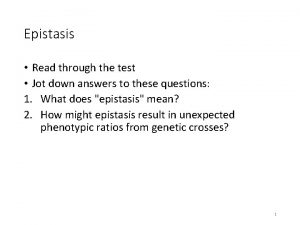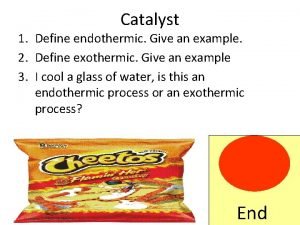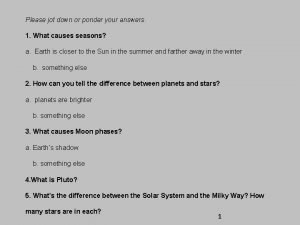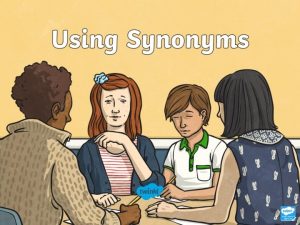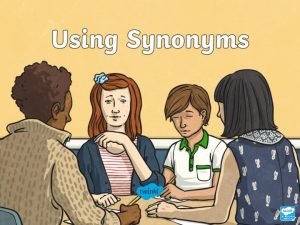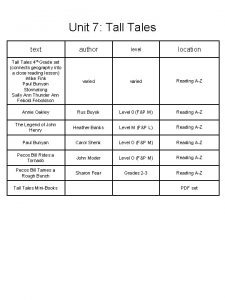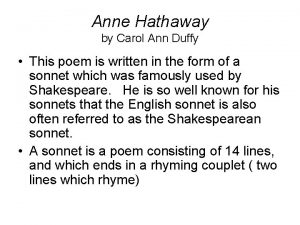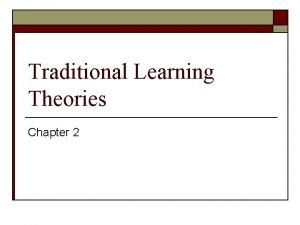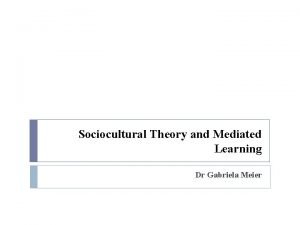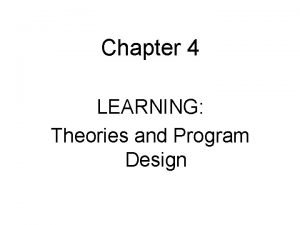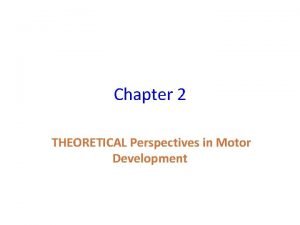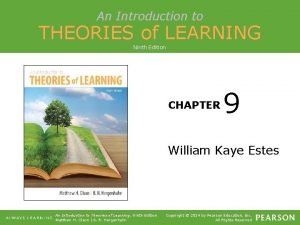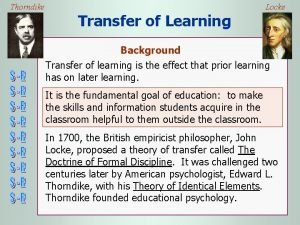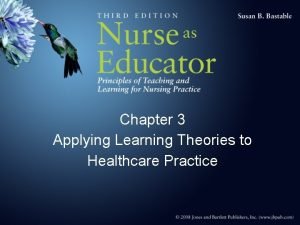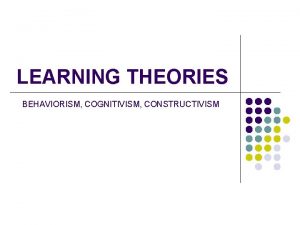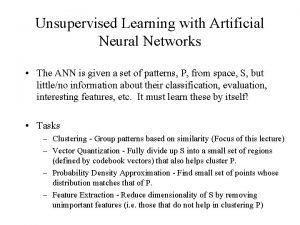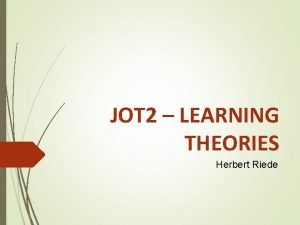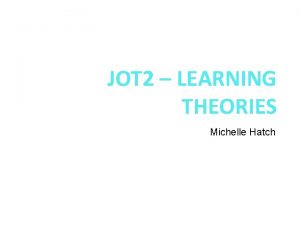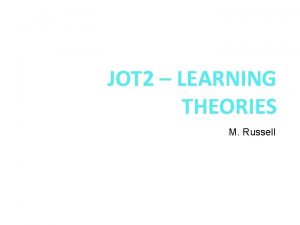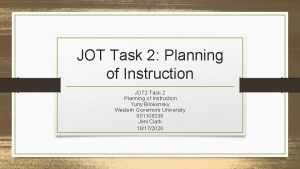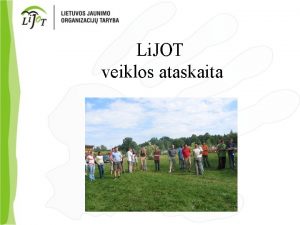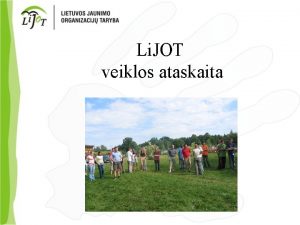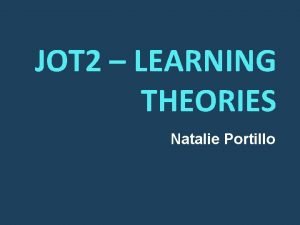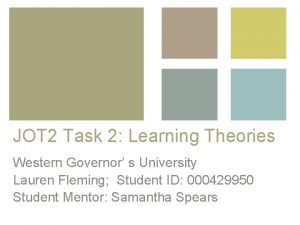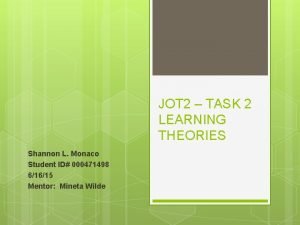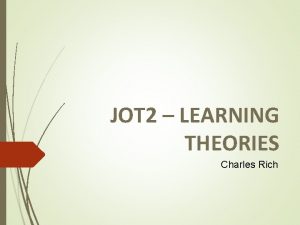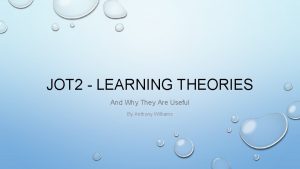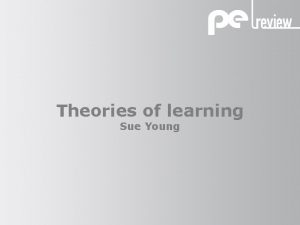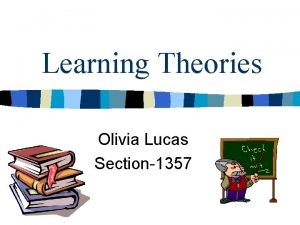JOT 2 LEARNING THEORIES Le Ann Polensky NOTE




























- Slides: 28

JOT 2 – LEARNING THEORIES Le. Ann Polensky NOTE: Please be sure to download the actual assessment task and rubric from Task. Stream and carefully read what each task requires.

Task A: Learning Theories & Learners Constructivism, Cognitivism, Behaviorism

When Constructivism is Beneficial for Learners ● When transfer of knowledge to problem solving is needed ●When group cooperation and problem solving is needed ●When students have different learning styles/intelligences

When Cognitivism is Beneficial for Learners ● When students need to relate information to prior knowledge. ● When students need to transfer knowledge to new contexts. ● When students need to learn an easier skill set before being presented with a more complex set.

When Behaviorism is Beneficial for Learners ● When students need to master basic skills and fluency. ● When observable and measurable outcomes are needed to demonstrate mastery. ● When students need different types of reinforcement (positive/negative) to motivate learning.

Task B: Learning Theory Used in Lesson Plan

Learning Theory – Lesson Plan ● Lesson Plan: Nickels and Dimes as well as Time ● The learning theory exhibited in this lesson plan is behaviorist. ● ● ● Students are memorizing facts The teacher is leading the instruction The teacher is leading the activities A stimulus is presented to elicit a response Knowledge is constantly checked and students are rewarded for the correct answer

Task C: Adaptation of Lesson Plan

Lesson plan in Cognitivism ● Adding Learning Centers ● Hickory Dock ● In this center, one student will hold a paper mouse and the other will hold an analog clock. One student will turn the minute hand of the clock as they both sing the nursery rhyme “hickory dock. ” When the song ends, the student holding the mouse will read the time and the students will talk about whether or not that was correct and why.

Lesson plan in Cognitivism ● Adding Learning Centers ● What would I do? ● In this center, students are provided with paper and an analog clock. They make a time on the clock, draw the clock on their paper and then draw a picture of something that they would be doing at that time of day. Then students would switch papers with their partner and talk about the time and the drawing. They would ask each other questions about what they would be doing at that time of the day and talk about how the drawing would change if it were the opposite time of day (AM or PM).

Lesson plan in Cognitivism ● Collaborative discussion ● What would I do? ● Based on what the students drew in their centers, we would talk about time as a group. Students can share their drawings. Then, I would make a time on the clock and have students act out what they might be doing at that time. Then students can talk about what they acted out and how that would change based on whether the time was AM or PM.

Task D: Lesson Plan Discussion

Most Beneficial? ● The version of the lesson that would be most beneficial to the students would really be a combination of both.

Most Beneficial? ● Behavorist ● ● ● This version of the lesson plan would be beneficial to the students because they are being introduced to new concepts and ideas. There is important vocabulary involved that needs to be memorized for success. Due to lack of prior knowledge, the teacher needs to lead the instruction to introduce the concepts. The teacher needs to be able to have an observable outcome to assess students to determine their prior knowledge.

Most Beneficial? ● Cognitivist ● ● ● This version of the lesson plan would be beneficial to the students because they are forming their own ideas and creating relationships between time and their surroundings. They are interacting collaboratively and helping teach one another while still being guided by the teacher. Their progress can still be assessed, but it is not as rigid and more difficult to observe

Task E: Effective Instruction Through the Use of Design Theories

Design Theories and Learning ● ● ● Different theories of design provide an effective learning environment for all students based upon which modality helps the individual learn best. Each student has individual needs and learning theories provide instructors with a way to differentiate instruction and tailor it to each student. The learning theories are also useful based upon the final outcome desired. Some topics such as spelling are best mastered through memorization whereas other topics such as cellular mitosis lend themselves to more constructivist methods.

Task F: Design Theories Strengths and Limitations: ● Wiggins ● Gagne ● Teaching for Understanding (The Harvard model)

Strengths of Wiggins Theory ● Desired results are determined before the lesson ● ● “Backwards-Design” Lessons are created to ensure students know and understand what will be on the assessment Teachers are able to ensure that students have all of the required knowledge before the assessment. Students will most likely understand the material well, as they will not be lost in the details

Limitations of Wiggins ● Teachers are limited to teaching only what is on the test. ● ● Students are not able to explore other material ● ● Test-centered, not learning centered Cannot dig into things that interest them Centered around 6 facets of understanding ● Not necessarily meeting all students’ needs

Strengths of Gagne’s Events ● ● Very structured Learning hierarchy ● ● Lower level skills are learned before more difficult skills Students are provided feedback in order to assess their own learning

Limitations of Gagne’s Events ● Long model with many steps ● ● Missing a step for planning Very repetitive ● Students may become bored

Strengths of Teaching for Understanding ● Uses Generative Topics ● ● Understanding Goals ● ● Interesting to students and offer opportunities for multiple connections Long term and constantly updated Performances of Understanding ● ● Students expand upon what they already know Build and demonstrate their understanding

Weaknesses of Teaching for Understanding ● Teacher must predict student baseline skills ● ● Changes ● ● No steps for testing prior knowledge Many changes must be made to develop the most effective learning environment Early Skills ● ● Complex and builds on prior knowledge Not as effective with brand new skills (lower grades)

Task G: Most Suitable Design Process

Most Suitable ● Gagne’s design process ● ● ● Students will need incredible amounts of scaffolding Varied skill levels of the students Elicits practice Provides guidance to the learners Provides feedback needed to assess their own learning

References ● ● ● ALPS: Teaching for Understanding. Retrieved October 16, 2014 from Harvard Learnweb: http: //learnweb. harvard. edu/alps/tfu/info. cfm Ertmer, P. and T. Newby (1993). Behaviorism, cognitivism, constructivism: Comparing critical features from an instructional design perspective. Performance improvement quarterly 6(4), 50 -72. Gagne, R. (1988). The events of instruction. Principles of instructional design (pp. 185 -204). San Diego: Harcourt Brace College Publishers.

References ● Roblyer, J. E. (2001). Learning theories and integration models. Integrating educational technology into teaching. Upper Saddle River, NJ: Merrill
 Jot air balloon
Jot air balloon Naczelnik osp wymagania
Naczelnik osp wymagania Jot down questions
Jot down questions Jot cheetos
Jot cheetos Please jot down
Please jot down Write down synonym
Write down synonym Jot down synonym
Jot down synonym Tall tale
Tall tale Duffy anne hathaway
Duffy anne hathaway Difference between note making and note taking
Difference between note making and note taking Signal words
Signal words Difference between note making and note taking
Difference between note making and note taking Financial documents in order
Financial documents in order Debit note meaning
Debit note meaning Debit note là gì
Debit note là gì Note taking definition
Note taking definition Simple discount
Simple discount Cuadro comparativo de e-learning
Cuadro comparativo de e-learning Traditional learning theories
Traditional learning theories Dr gabriela meier
Dr gabriela meier Learning theories and program design
Learning theories and program design Dynamical systems theory motor development
Dynamical systems theory motor development Cognitive learning theorist
Cognitive learning theorist An introduction to theories of learning
An introduction to theories of learning Thorndike's theory of learning
Thorndike's theory of learning Applying learning theories to healthcare practice quizlet
Applying learning theories to healthcare practice quizlet Psychological factors influencing learning
Psychological factors influencing learning Behaviorism vs cognitivism vs constructivism
Behaviorism vs cognitivism vs constructivism Ann unsupervised learning
Ann unsupervised learning


